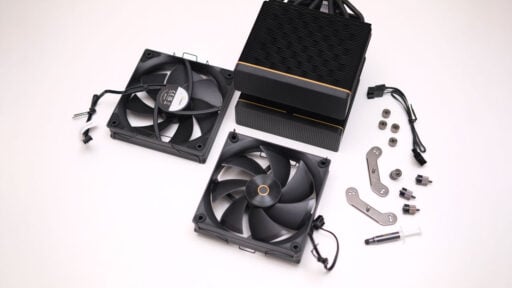The ROG Swift PG27VQ is one of the very first curved gaming displays with Nvidia G-Sync and a 165Hz refresh rate. Those features are huge during its time especially with RGB lighting in tow. This review is going to be a little harder on the monitor though due to the emergence of new crowd favorites and performance oriented contenders as well.
Now, the PG27VQ still remained as a premium offering for full two years with an updated MSRP of $639.99 around the globe. That said, its 165Hz refresh, WQHD, 1800R curvature panel and the proper G-Sync kit are all to blame – in a positive way.
Table of Contents:
- 1 Technical Specifications
- 2 Packaging and Accessories
- 3 Design, Layout and Build Quality
- 4 On-Screen Display Menu
- 5 Test Setup and Methodology
- 6 Color Gamut
- 7 Tone Response
- 8 Brightness
- 9 Contrast Ratio
- 10 Screen Uniformity
- 11 Color Accuracy
- 12 Power Consumption
- 13 Button to Pixel Input Lag
- 14 Motion Clarity: MPRT
- 15 Motion Clarity: Pursuit Camera
- 16 Backlight Bleed
- 17 Viewing Angles
- 18 Frame Skipping
- 19 Software, Lighting and Special Features
- 20 Final Thoughts
Technical Specifications
| Display | |
| LCD Size | 27″ |
| Aspect Ratio | 16:9 |
| Resolution | 2560 x 1440 |
| Refresh Rate | 165Hz (Adaptive) |
| Pixel Pitch | 0.233mm |
| Brightness | 400cd/㎡ |
| Contrast Ratio | 1000:1 |
| Panel Type | TN (1800R) |
| Response Time | 1ms (GtG) |
| Connectivity | |
| Display Options | 1x DisplayPort 1.2, 1x HDMI 2.0 |
| USB | 2x USB 3.0 |
| Audio | 1x 3.5mm (Out) |
| Ergonomics | |
| VESA Wall Mount | 100 x 100mm |
| Pivot | NA |
| Swivel | -40°/+40° |
| Tilt | -5°/+20° |
| Hight Adjustment | 0-100mm |
| Dimensions | |
| Length | 615mm |
| Width | 37mm |
| Height | 114mm |
| Weight | 8.5kg (With stand), 5.8kg (Without stand) |
Packaging and Accessories
The ASUS ROG Swift PG27VQ comes packed inside a huge packaging. Listed below are the bundled items:
- Power cord
- Power adapter
- DisplayPort cable
- USB cable
- Quick start guide
- Acrylic LED light covers
- HDMI cable
- Support CD
- Warranty Card
Design, Layout and Build Quality
The ASUS ROG Swift PG27VQ is the epitome of 2017’s gaming products with interesting design choices as well. The front for an instance, sports a distraction-free 1800R curved panel, while the back sports a more aggressive in-your-face styling. As for the TN panel itself, pixel density is rated at 0.233mm. That’s spot-on perfect for a monitor with 2560 x 1440 of resolution at 27 inches.
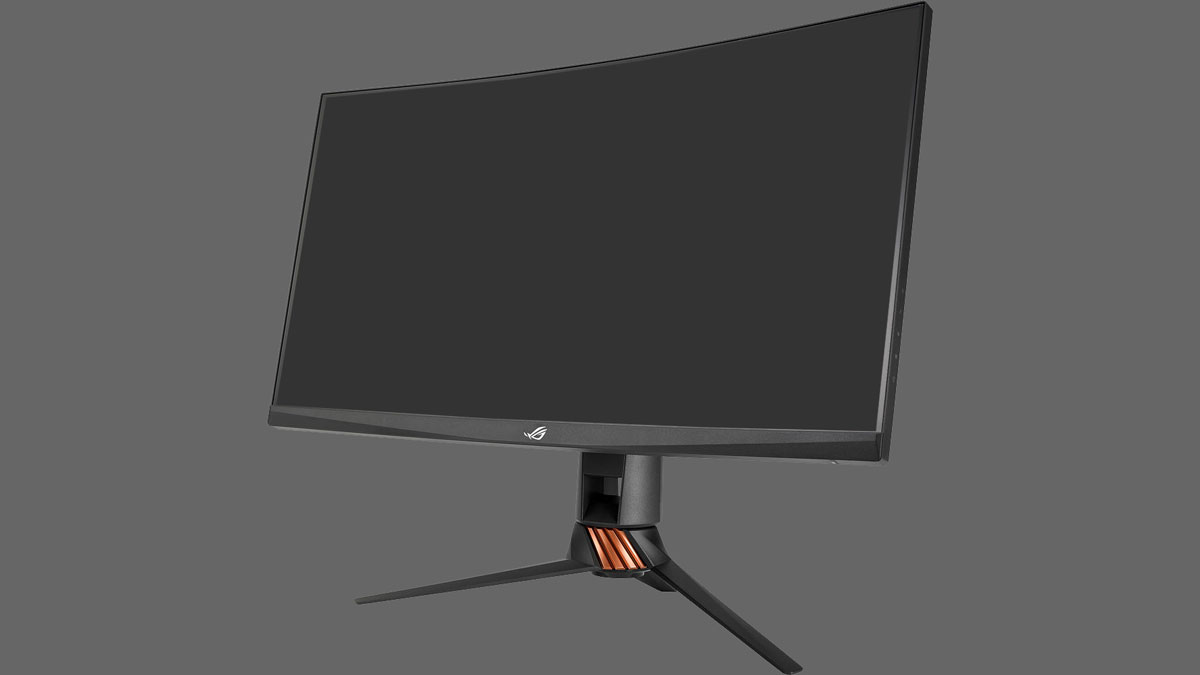
The guys from ASUS utilized a blend between gloss and a matte finish coating for the PG27VQ. This is a usual feature found on most gaming displays nowadays. Bezel and panel frame thickness is about 7mm total, so you could put at least another one without much fuss. Curvature on the other hand is again 1800R. Decent by today’s standards and not as tight as a 1500R display on a 27″ panel.
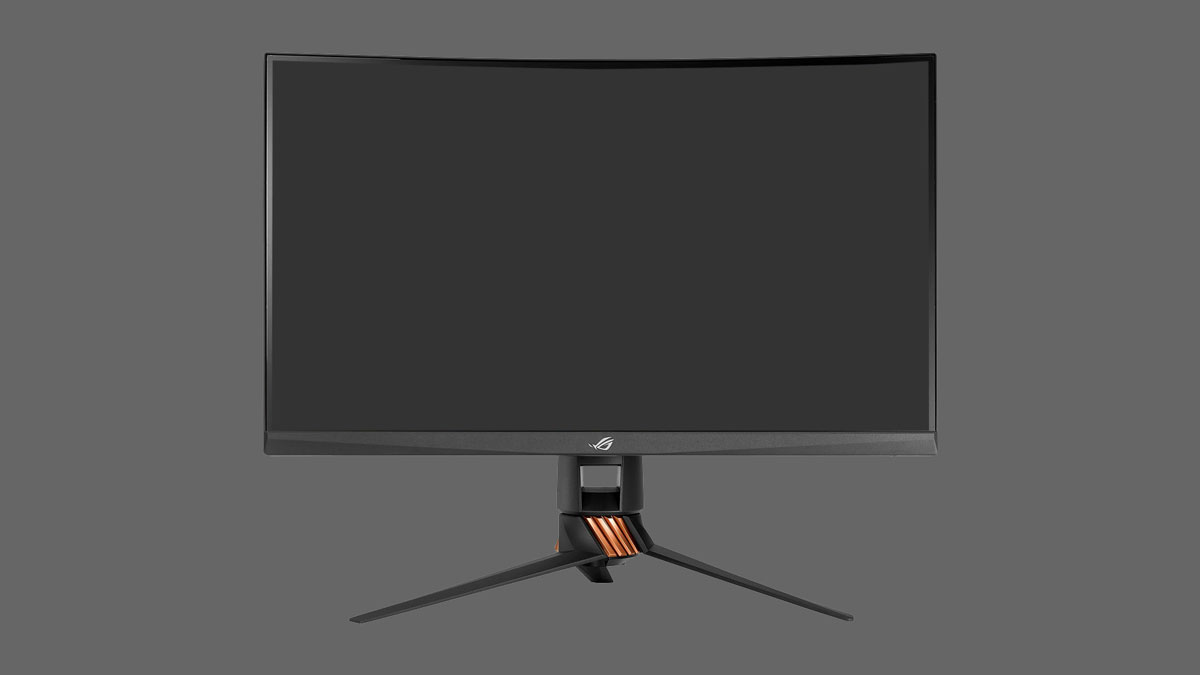
Ergonomically, the ASUS ROG Swift PG27VQ could tilt and swivel. No pivot option here folks with a lower tilt and swivel values to boot. The option to use a VESA mount of your own is appreciated though. This thing weights in at 5.8 kilograms without the stand. Perfectly fine for even the most budget wall and desk mounts. And yes, this thing comes with ASUS AURA Lighting enabled RGB back panel area.
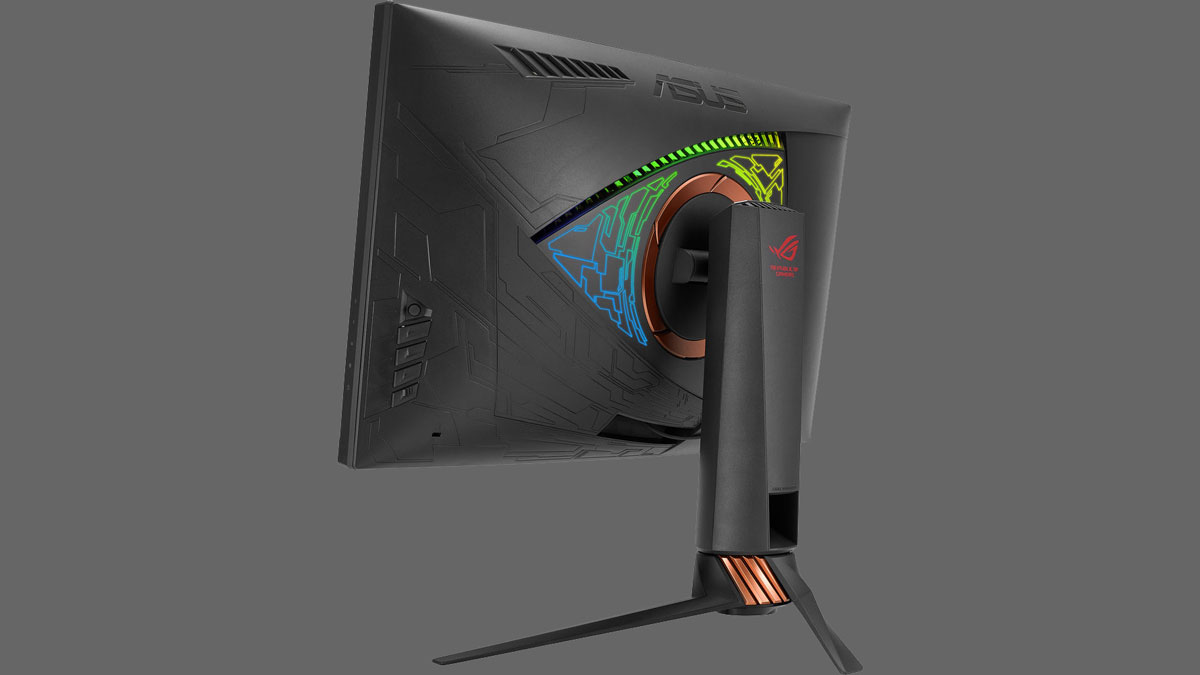
As for display options, ASUS went with a single HDMI and a single DisplayPort. This is a 2 year old panel, so DP standard is 1.2. Luckily, that shouldn’t pose any problem with Nvidia cards capable of G-Sync since it has its own G-Sync kit. Power on the other hand is external but we’ve got a nice set of OSD buttons with a joystick in tow.
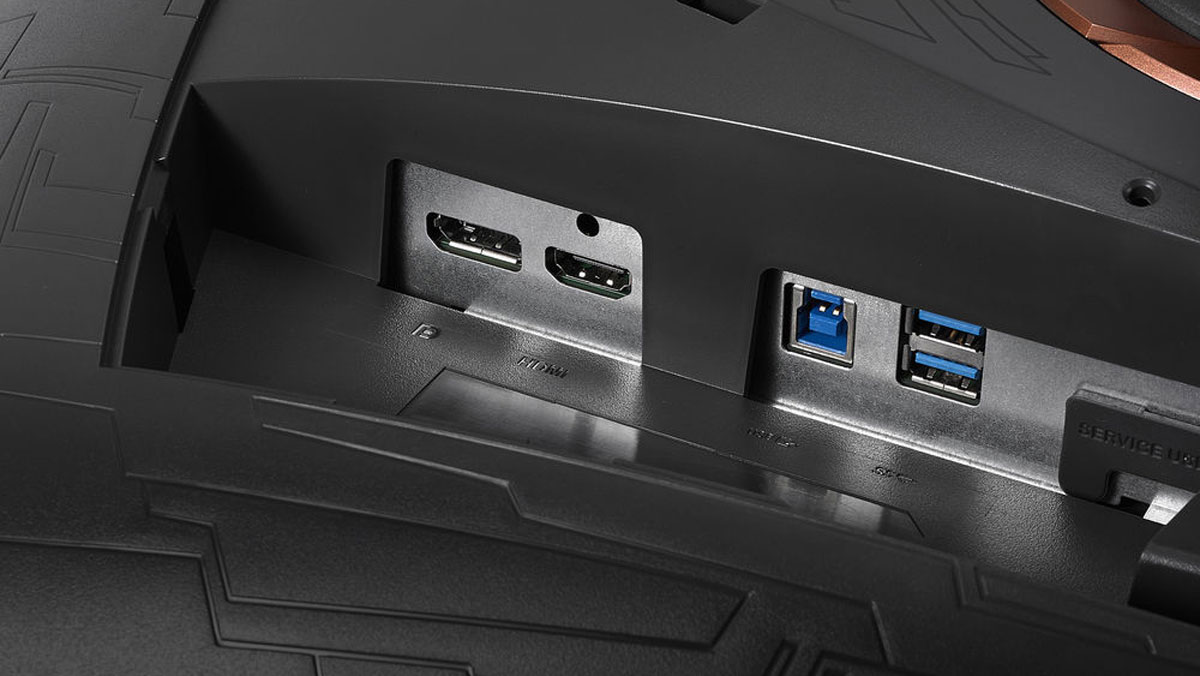
Now this is VESA mountable and ASUS provided the necessary spacers for you to be able to mount it just fine with most adapters out there. All you need to do is to remove the ring with a dampened flat screw driver, remove the stand, attach the spacers and the VESA mount.
On-Screen Display Menu
The Swift PG27VQ features that classic ASUS ROG OSD menu found on most ROG monitors. We have 6+1 menus here with the GameVisual mode featuring its own button, housing the most common presets.
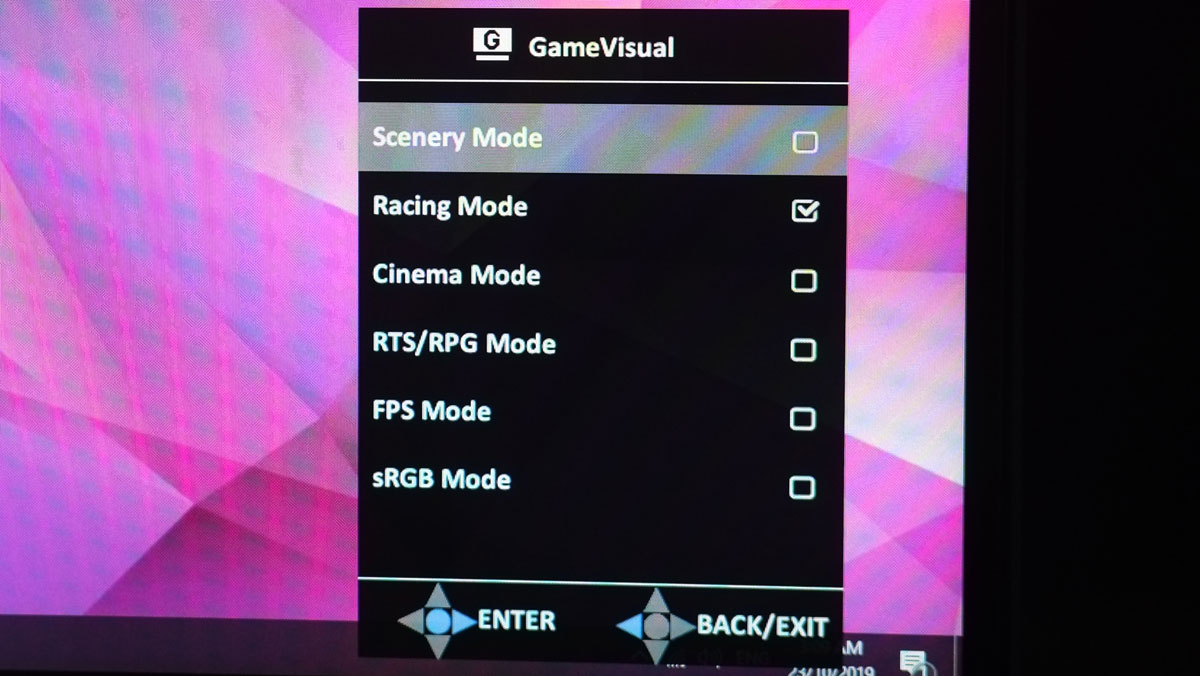
Overclocking is up next, featuring that simple toggle between 144Hz and 165Hz. Blue light filter on the other hand is the second option. We have 5 levels here to play with. Personally, I find Window’s very own Night light feature a better option.
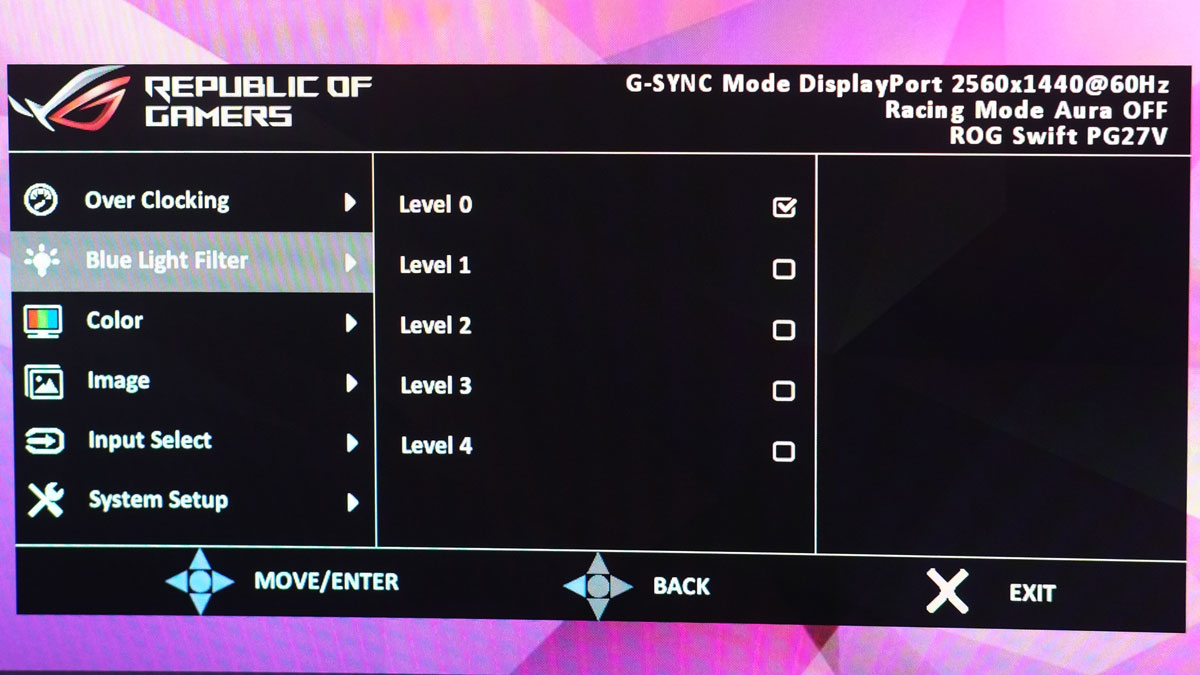
Color menu is where you could setup the brightness, contrast, saturation, color temperature and gamma. Image on the other hand is where Overdrive, Adaptive contrast, Dark boost and ULMB are set up. Do note that some of these might be disabled based on the GameVisual mode selected.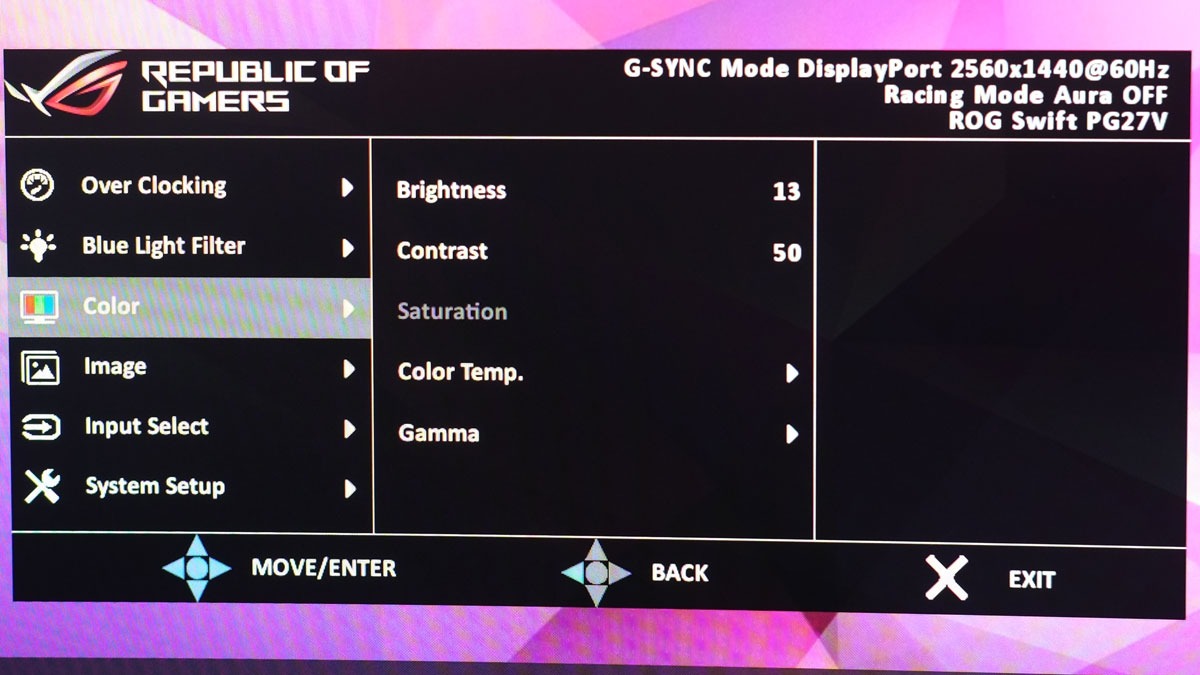
The Input Select menu on the other hand is self explanatory. System Setup is where the Aura Sync, Aura RGB and a few more self explanatory settings could be found. Light in motion is basically the option for the holographic LED at the bottom of the base.
Test Setup and Methodology
Our test setup relies on the Blur Busters TestUFO Motion Tests and the Data Color Spyder5ELITE Display Calibration System. The cameras used throughout the review for the motion artifact and high speed assessments are the Fujifilm XE-1 and the Nikon 1 J1.
| Test System Specifications | |
| CPU | Intel Core-i5 6600K |
| Motherboard | ASUS Z170-A |
| Cooler | Noctua NH-L9i |
| Memory | ADATA Premier DDR4 |
| GPU | ASUS ROG Strix GTX 1060 OC |
| Storage | Crucial BX200 480GB |
| Case | Thermaltake Core P3 |
| PSU | CORSAIR RM850X |
| Display | DELL U2715H |
| OS | Microsoft Windows 10 Pro |
Target for calibration is a 2.2 Gamma value, with a White Point at 6500K and a Brightness value set at 120 cd/㎡. Calibrated values are then analyzed with the Spyder5ELITE Display Analysis tool. Do note that Dynamic Contrast Ratio and other extra features built within the OSD are disabled during the tests. The following OSD values are selected for the display calibration.
| OSD Settings | |
| Brightness | 13 |
| Contrast | 50 |
| Saturation | NA |
| Temperature | User (R100, G100, B100) |
| Gamma | NA |
| Preset | Racing |
If you wish to use the calibrated ICC profile taken from our Spyder5ELITE result, just send us a message. You may also read our guide on how to use ICC profiles.
Color Gamut
The Color Gamut test evaluates the color spaces the display exactly covers. That includes industry standard spaces such as sRGB and AdobeRGB. Higher percentage values are better.
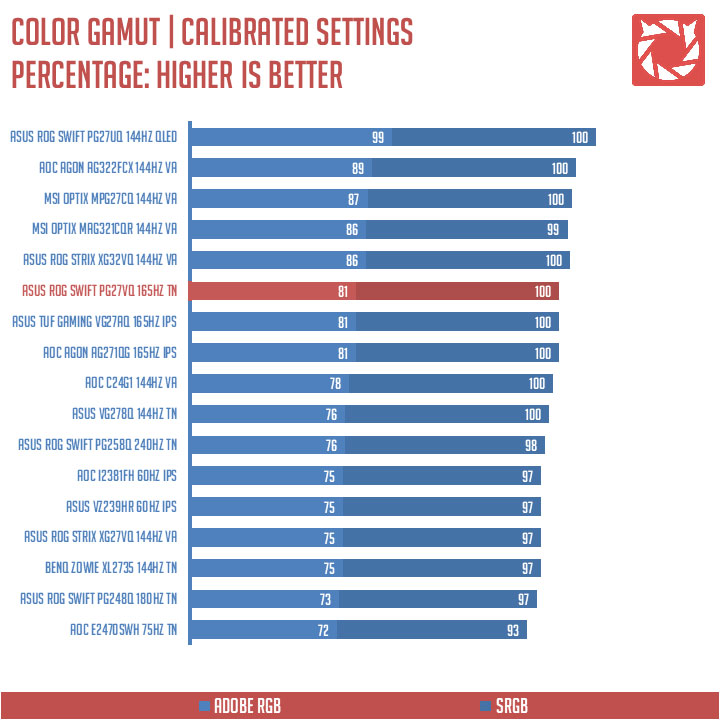
Color space coverage of the PG27VQ spot on 100% at the sRGB coverage. AdobeRGB coverage on the otherhand is at 81%. Up with the best, but it is still to early to draw a conclusion.
Tone Response
Tone response is where we check the display’s Gamma value and or presets if there are any. We then compare the results with industry standard of 2.2. Closer to this value is better.
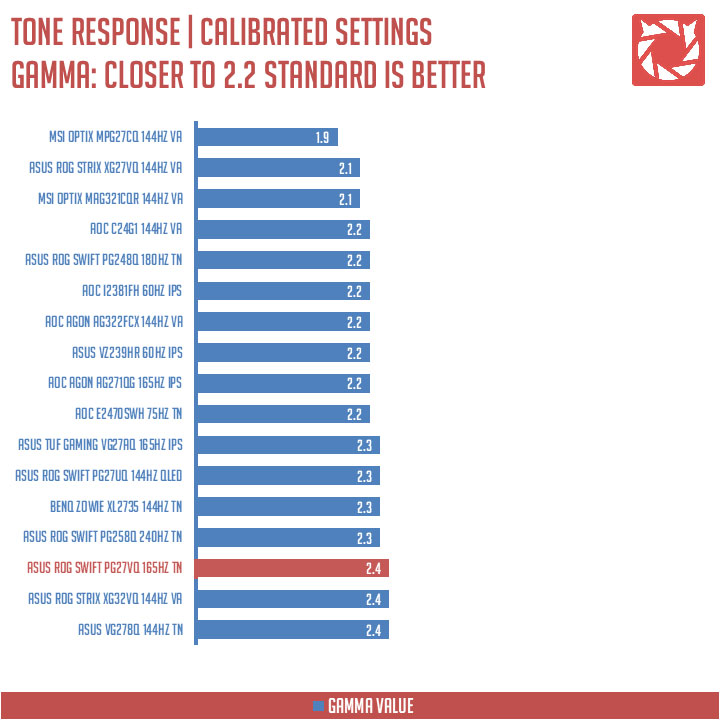
Now tone response is kinda weak. Its gamma level of 2.2 registers at 2.4, while the 1.8 and 2.4 nets results of 1.9 and 2.6 respectively.
Brightness
The result of the test here will shows us an overview on how the display actually performs in terms of Brightness measured in candela per square meter (cd/m2). Higher is better.
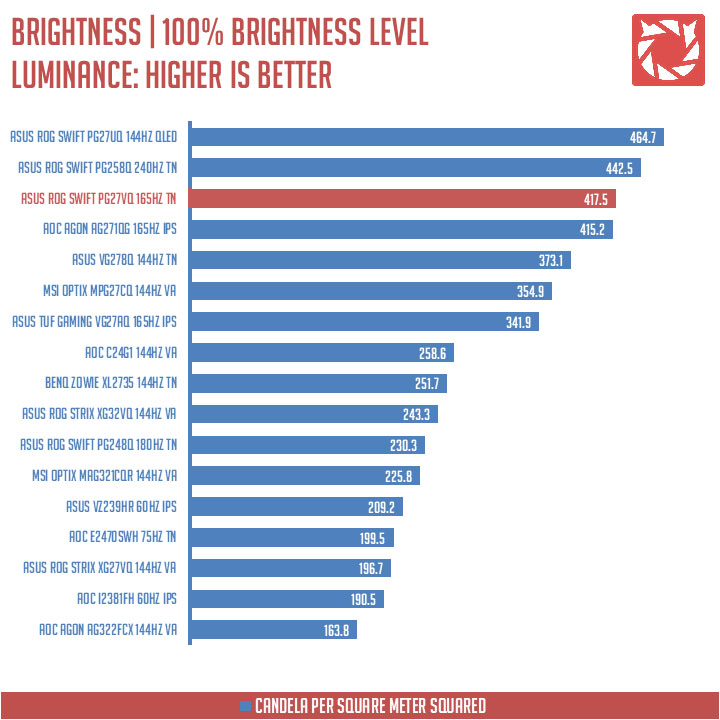
Brightness at 100% is rated at 417.5 cd/㎡ which is higher than specified. Funny enough, this should easily pass the pointless VESA DisplayHDR 400 certification.
Contrast Ratio
Static contrast ratio is also tested. The test here will shows us an overview on how the display actually performs in terms of Contrast measured in luminance ratio. Higher is better.
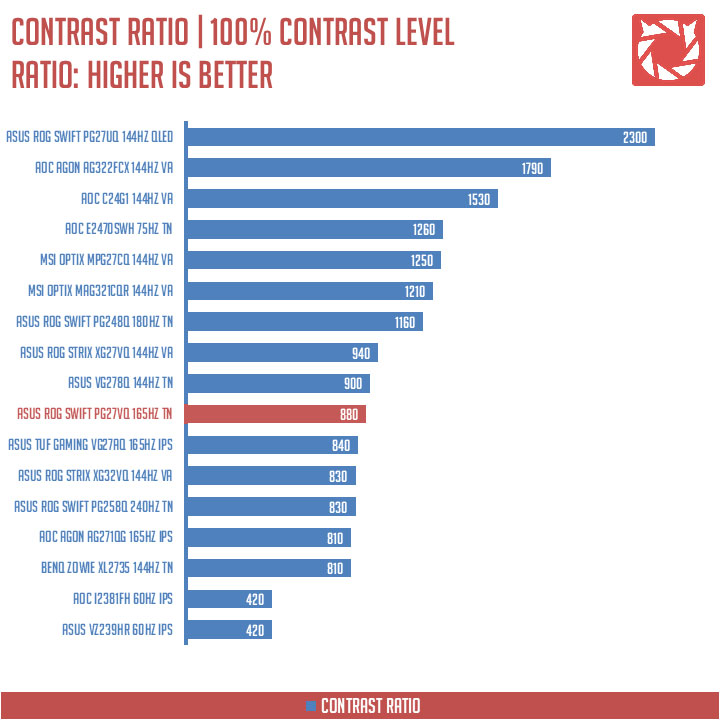
Static contrast ratio at 100% contrast level is at 880:1. Not quite the best based on the results we got but it is not bad either.
Screen Uniformity
This test shows us an overview of the screen’s uniformity at the calibrated brightness level. The closer this value to 0, the better the quality of the panel.
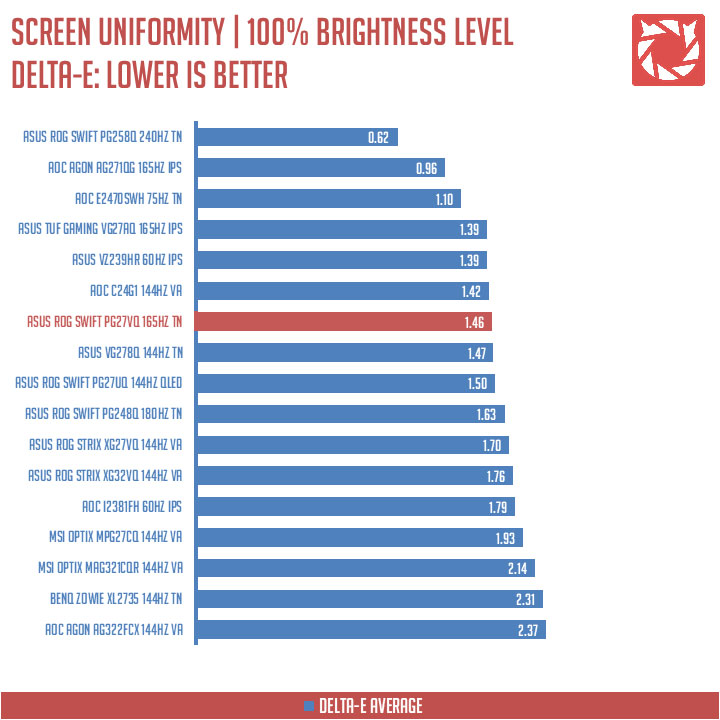
Screen uniformity on the other hand is pretty good with a Delta-E value of 1.46. The lower left and lower right corners of the panel are the worst performers here as far as this test is concerned.
Color Accuracy
This test shows how well different basic color hues are being reproduced by the display. These color tones correspond with the Datacolor SpyderCheckr. Lower Delta-E values are better.
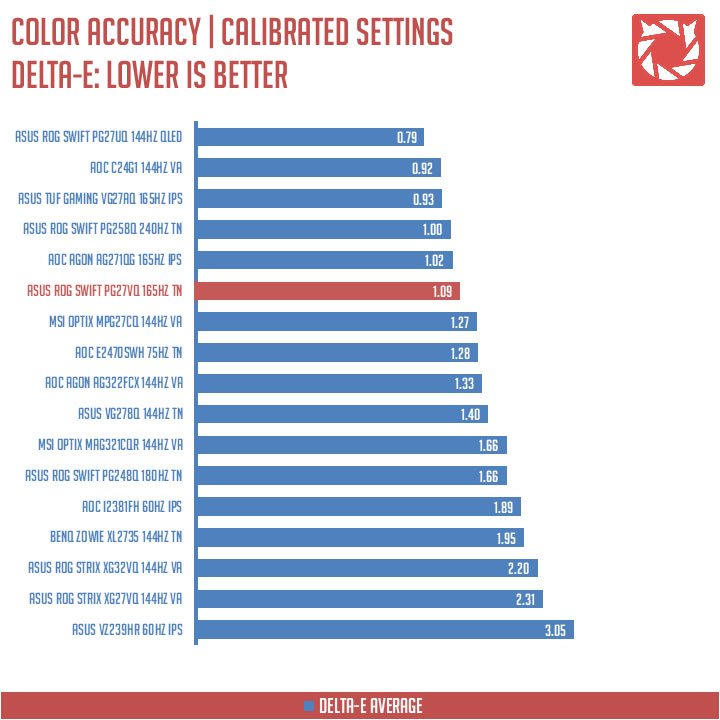
The PG27VQ scored an average of 1.09 Delta-E value. Excellent results we got here from the curved 27 inch TN panel.
Power Consumption
The power consumption is checked with a power meter. Measurements are taken at maximum brightness level.
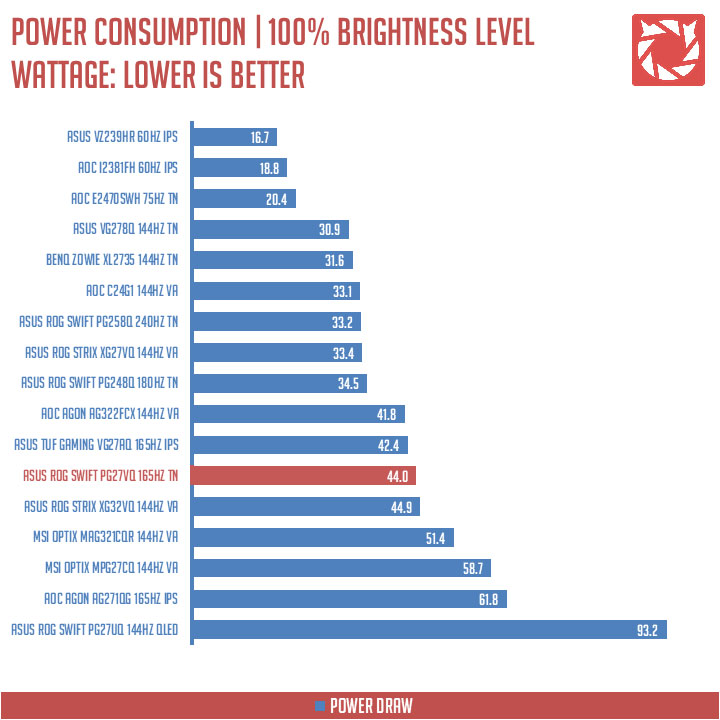
The ASUS ROG Swift PG27VQ consumes maximum power of 44.0W. Not bad at a scorching 100% brightness level.
Button to Pixel Input Lag
The Button to Pixel Input Lag is a combination of system latency from the point of input, processing and display output. That is the basic of it and to quantify the approximate Button to Pixel Input Lag, we utilized Quake 3 Arena as our main shooter. The game is set at the native resolution of the panel with the FPS locked at 250. We check how much delay in milliseconds it took the display to actually output the signal via a 1200 FPS high-speed camera with ~0.83ms of accuracy.
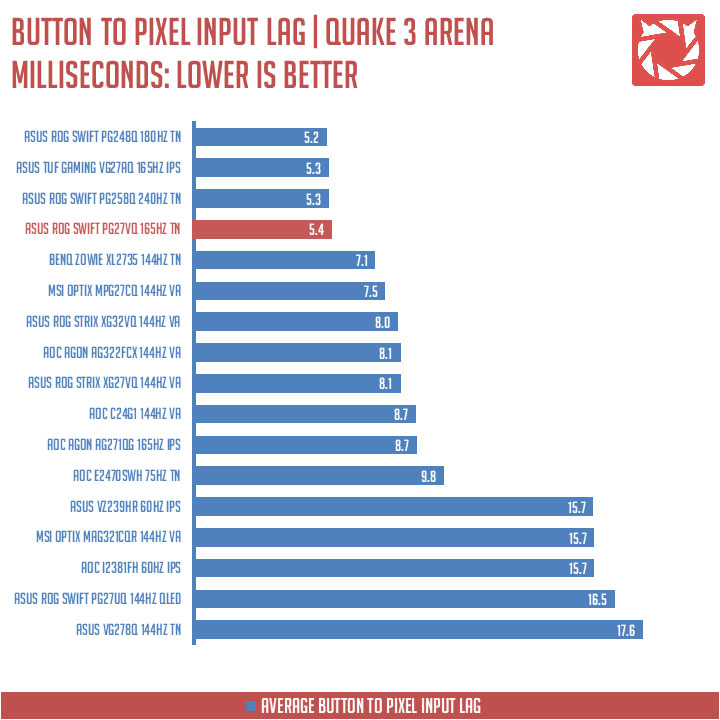
The button to pixel lag results shows that the ASUS ROG Swift PG27VQ has an average latency of 5.4ms. The 4th top notcher together with the other TN panels and the venerable VG27AQ.
Motion Clarity: MPRT
Motion Picture Response Time (MPRT) is the numbered approach to demonstrate the level of perceived motion blur on a display. Basically, a lower persistence value indicates less motion blur. Refresh rate and the sampling method plays a major part here whereas a higher refresh rate nominally features better display persistence values.
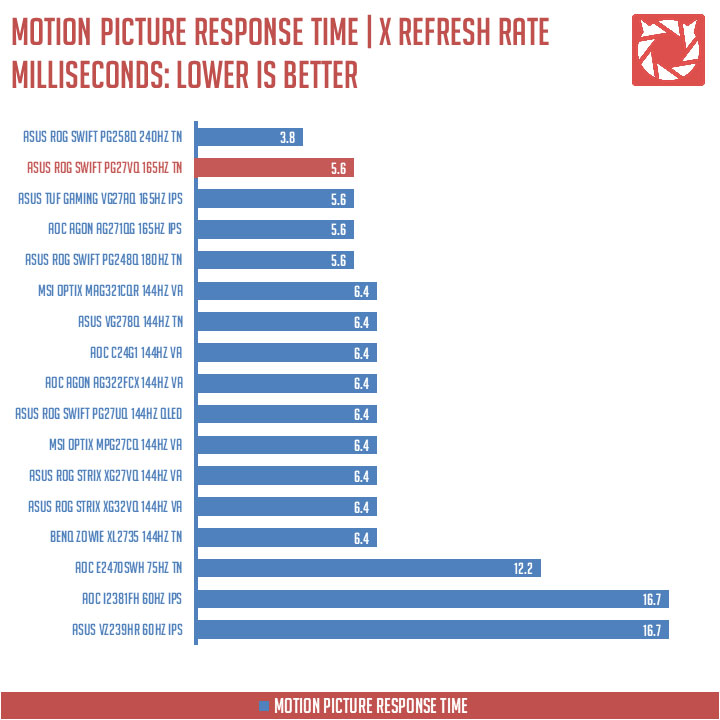
These results are references to check out the theoretical MPRT values of a display.
Motion Clarity: Pursuit Camera
Setting up a pursuit camera courtesy of Blur Busters allows us to a great extent, perceive the actual motion blur of the display. Using such method also allows us to check out for other motion artifacts including ghosting, inverse ghosting and other artifacts. This pursuit camera test is a peer-reviewed invention.
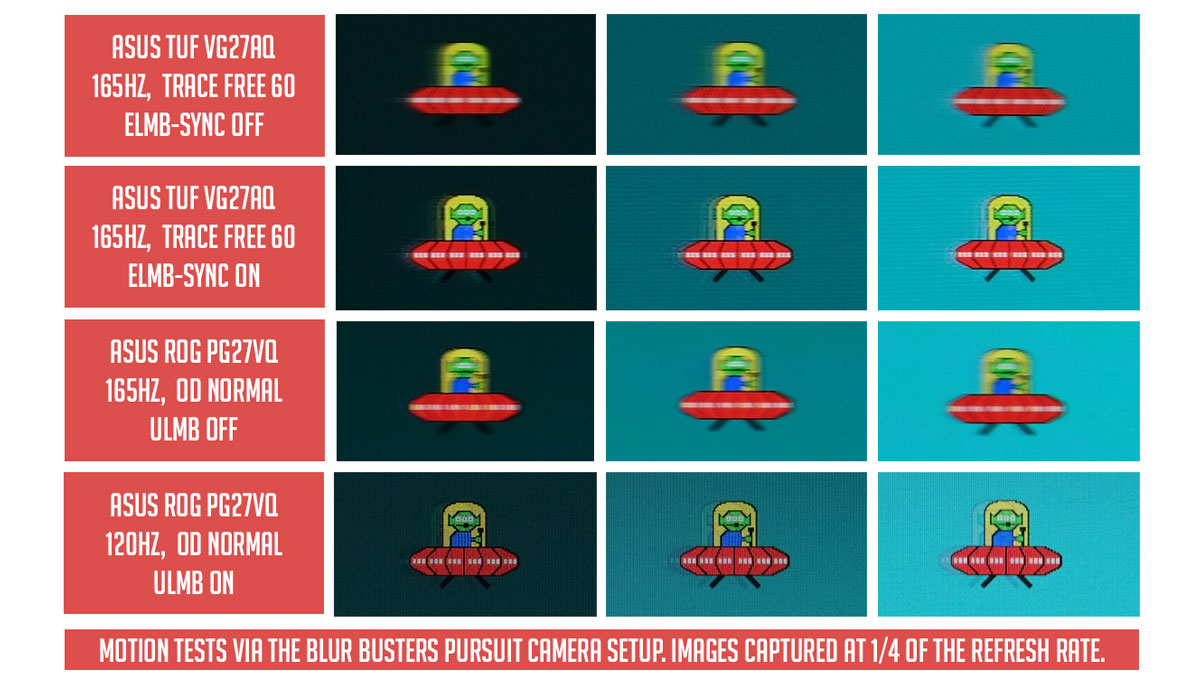
The ASUS ROG Swift PG27VQ is quite possibly one of the better 165Hz displays at ASUS’ disposal. Artifact at 165Hz for an instance is barely noticeable if there’s even any. As for ULMB, it is way better than ELMB Sync (clarity wise) at the limited 120Hz refresh rate. I’d say strobe crosstalk on this one is a cut above your usual ULMB display.
Backlight Bleed
Backlight Bleed is the phenomenon where backlighting from a display leaks. This is prevalent with LED backlight enabled displays where the LEDs used to light the panel are situated at the edges of the display. Testing the Backlight of the display is conducted on a dim room, simulating the recognizable amount of bleed for such scenario.

The backlight bleed of the ASUS ROG Swift PG27VQ is hardly visible around the edges of the screen. Like many recent ASUS displays, you wouldn’t really notice any of it unless you bump up the brightness.
Viewing Angles
Viewing angles are also tested to check out how the display panel performs on various positions. This should be helpful if you are looking for a panel that could be used on multi-monitor setups.
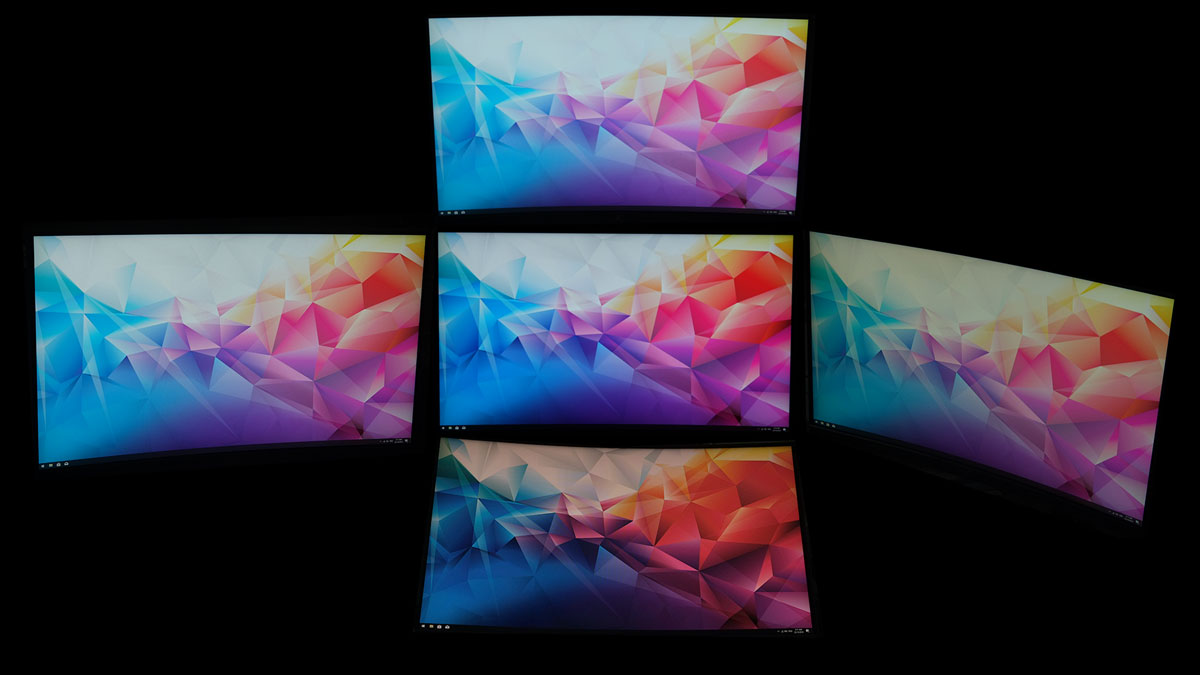
This is a TN panel, so we already expected such a lackluster extreme viewing angle performance compared to VA, IPS and OLED based displays. It shouldn’t matter that much though, since it is a curved panel. That said, it is not a total downside for this particular model.
Frame Skipping
Frame Skipping is the phenomenon where dropped frames and missing refreshes occur due to ineffective refresh rate overclocking. If your display exhibits such issues, it should be perceptually similar to in-game frame skipping. We are are utilizing the Blur Busters Frame Skipping Checker to test if there is any.
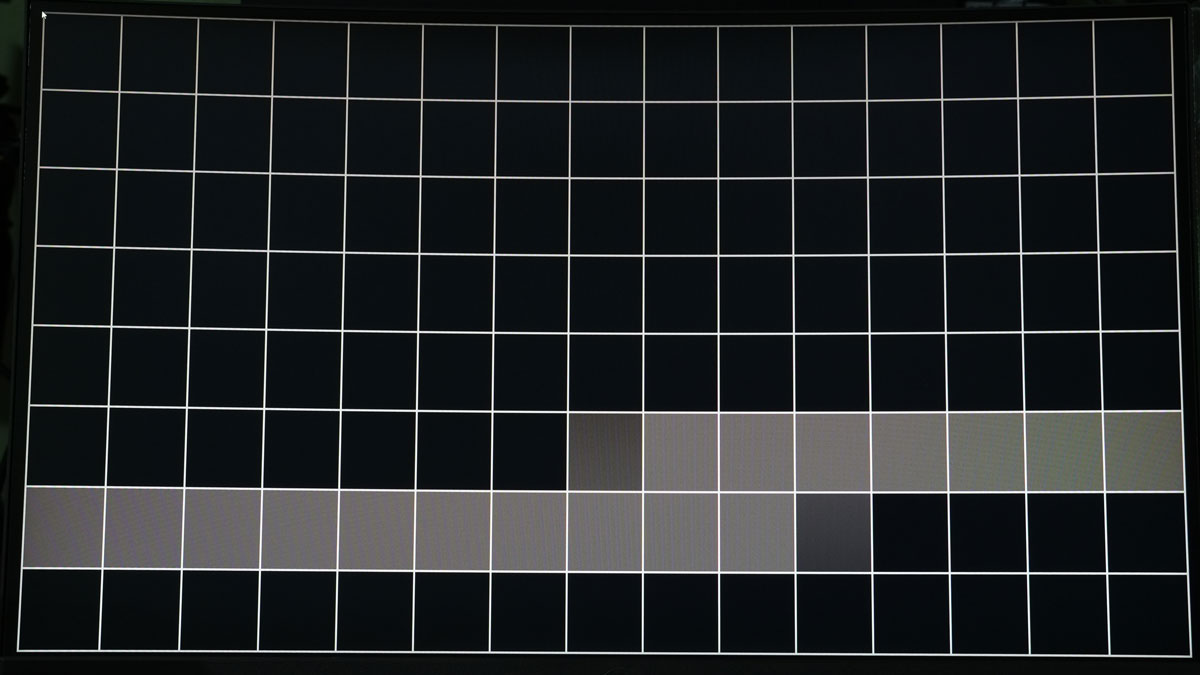
No worries here when it comes to our frame skipping test even at 165Hz.
Software, Lighting and Special Features
The ASUS ROG Swift PG27VQ supports a maximum of 165Hz so it’s pretty smooth and with a 1ms GtG response time, you’d get a responsive gaming experience out of the display. Now this is a G-Sync based display with a proper G-Sync kit inside. That means if compared it to G-Sync compatible displays and FreeSync, this will net better artifact control at lower frame rates via its variable overdrive technology. Simply put, the FGA based G-Sync kit itself handles variable refresh rate at a much better level compared to your usual VRR solution. Problem is you’re limited to the Green brand with this feature.

The G-Sync kit is also capable of ULMB. That’s a back-light strobing technology exclusive to G-Sync enabled panels. On this particular monitor, you could enable it at the expense of a lower maximum refresh rate (120Hz) and VRR turned off. Brightness is also hampered and some gamers do not like this feature at all. It is a feature from a flicker-based technology I must say.

Now the PG27VQ is also a curved gaming monitor with 1800R of curvature. Compared to your usual panel, curved ones with the right curvature allows for a much better FOV, enhances viewing angles and alleviates eye strain. It’ll take some time to get used to them but I assure you it is worth it.
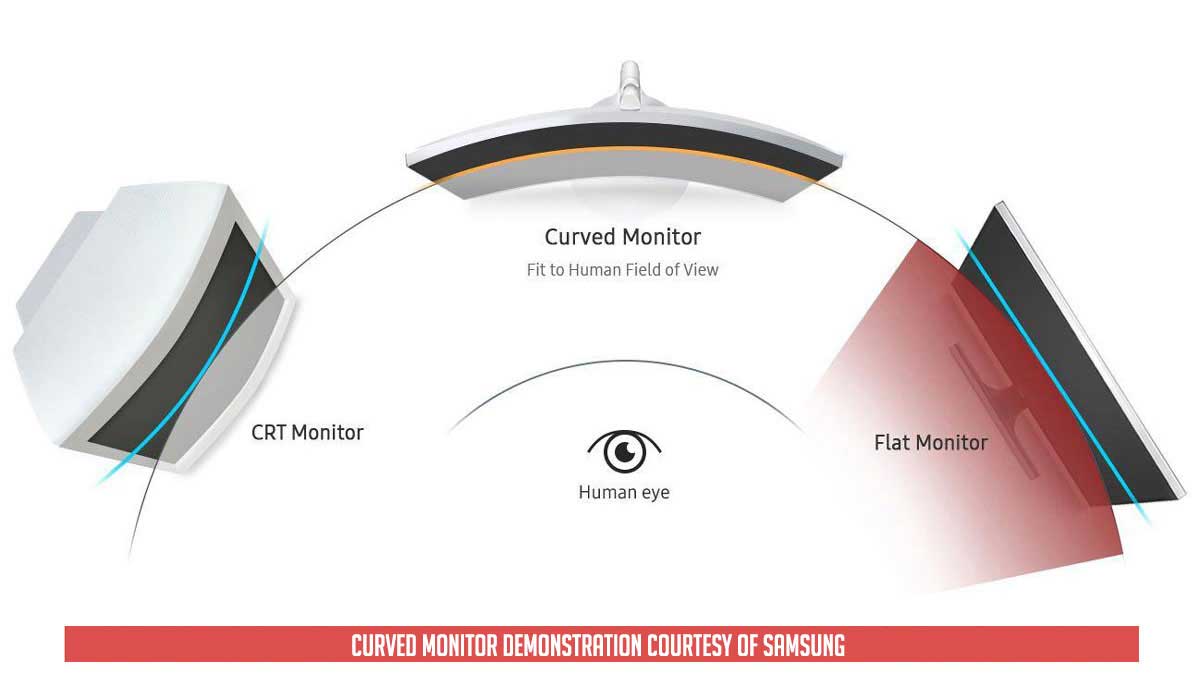
Now if you love to show off, then this monitor will not disappoint. Distraction-free is the design at the front yet distraction is the name of the game at the back. The ASUS Light in motion could be improved though, since it still – after all these years – feature a single color non addressable LED lighting.
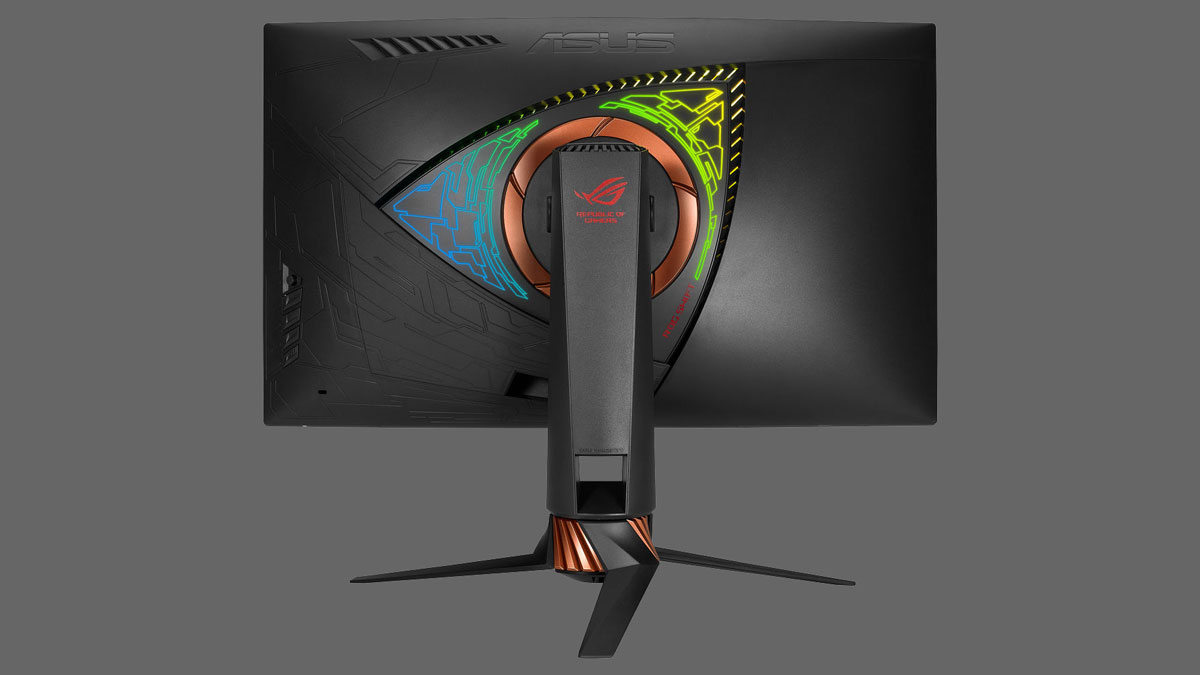
Final Thoughts
The ASUS ROG Swift PG27VQ is out of the box… a not so forgiving product. Color accuracy is not so err… accurate. Now a calibrated PG27VQ is on a different level compared to the stock. It’s like a new monitor really with vastly improved color tones and a bit improved gamut.
As for gaming, you cannot really fault this one. Motion clarity is spot on at 165Hz and ULMB is a nice option to enable. I just wish this one had ULMB at 144Hz instead of 120Hz. Since this one comes with G-Sync and a proper one at that, expect a smoother gaming experience compared to your usual G-Sync compatible display. I’d like to mention its 1800R curvature too. Pretty clever decision from ASUS since it really helps mitigating the limitations of TN panels. Lotsa options and features here folks with stunning design elements to boot.
Now pricing around the globe tells us that this one is a well-priced gaming monitor at $639 USD. There are many 165Hz displays with better panels at that price point yet if you are looking for a G-Sync display to maximize your Nvidia graphics card then this one is a cut above a few. Still one of the best after all these years.
ASUS ROG Swift PG27VQ Curved 165Hz Monitor Review
Summary
Now pricing around the globe tells us that this one is a well-priced gaming monitor at $639 USD. There are many 165Hz displays with better panels at that price point yet if you are looking for a G-Sync display to maximize your Nvidia graphics card then this one is a cut above a few. Still one of the best after all these years.
Pros
- Contrasting design elements
- Excellent response time
- G-SYNC module inside
- Excellent build quality
- Motion clarity
- Good ULMB implementation
- Excellent brightness levels
Cons
- Out of the box performance
- Price point
- Ergonomics

